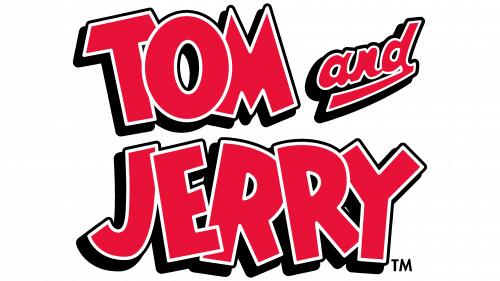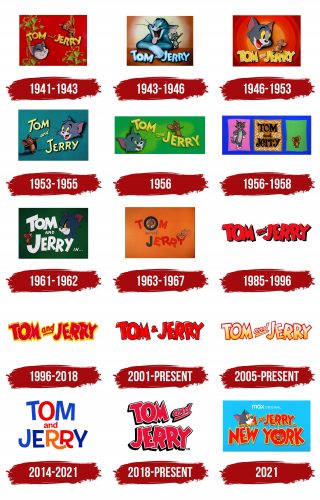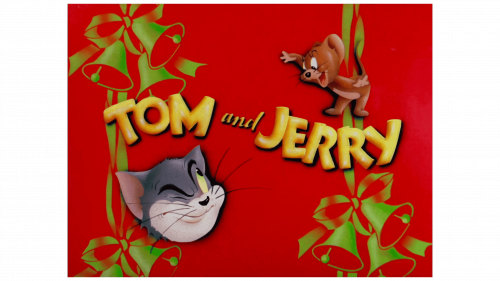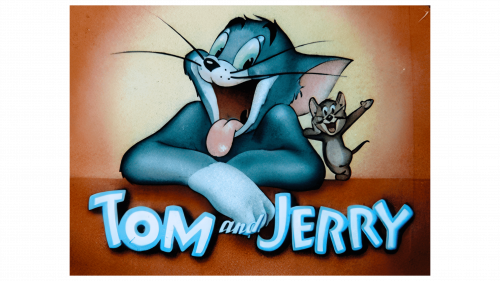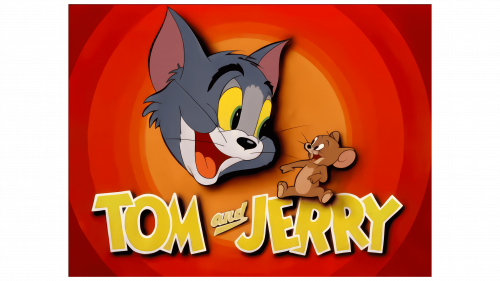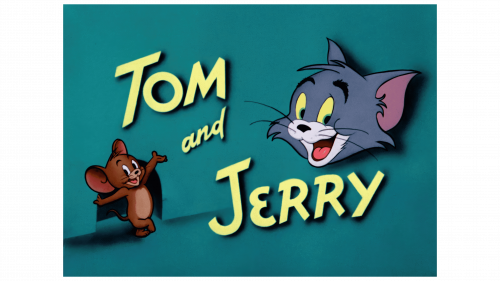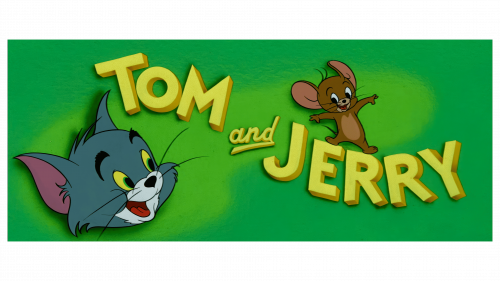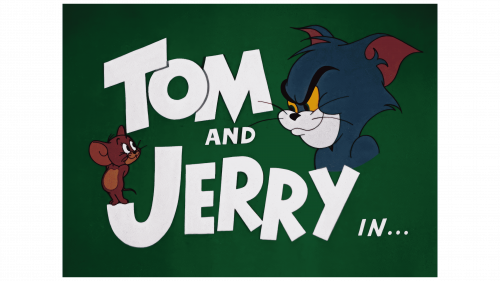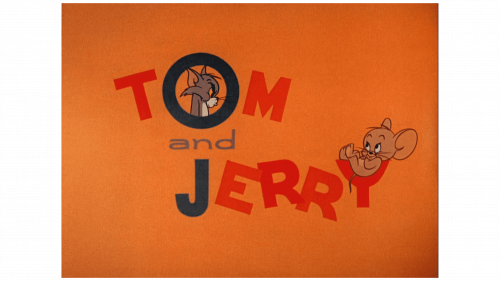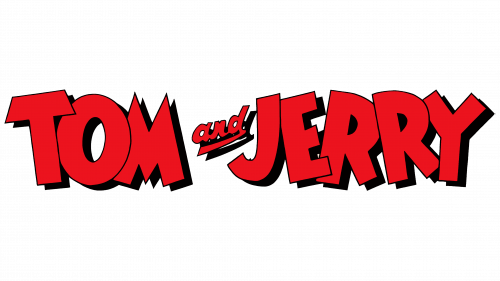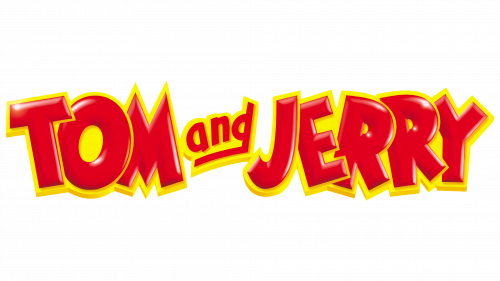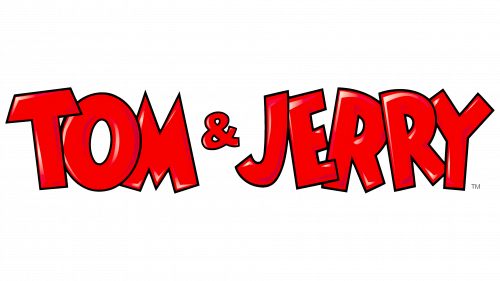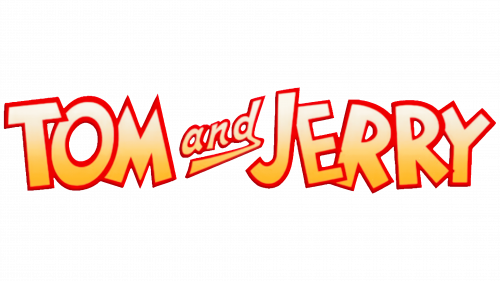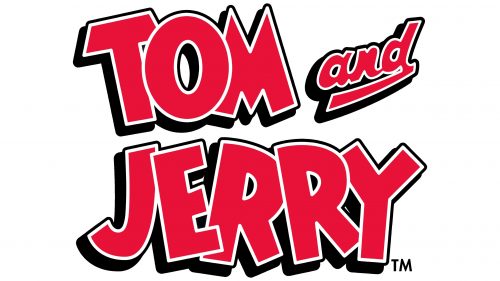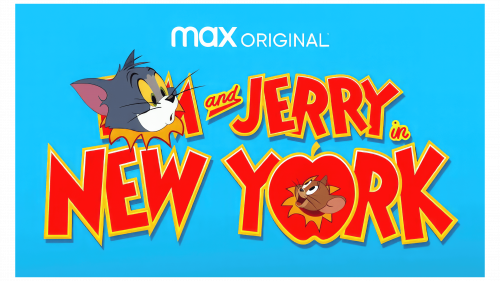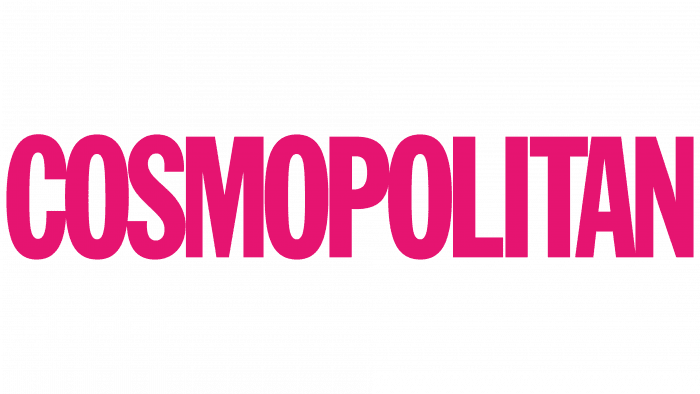The Tom and Jerry logo evokes the fun and carefree game of chase that viewers worldwide love. The bright and mischievous characters seem to come to life on the emblem, constantly chasing each other. The dynamic design effectively highlights the playful and restless nature of the cat and mouse, whose antics always bring laughter and charm. However, behind each of their tricks lies a bit of chaos, which proves costly for their owner, adding a spice to the action. The visual mark captures the adventurous spirit, where the never-ending chase remains exciting and entertaining.
Tom and Jerry: Brand overview
The origin of Tom and Jerry dates back to 1940 when Metro-Goldwyn-Mayer (MGM) hired animators William Hanna and Joseph Barbera. They aimed to create a new series of short cartoons that could compete with the popular animated programs from other studios at the time.
Hanna and Barbera focused on the classic theme of a rivalry between a cat and a mouse. Their first cartoon, Puss Gets the Boot, was released on February 10, 1940. In this initial short, the cat was named Jasper, and the mouse had no name; they were not yet known as the famous duo. The cartoon was a success and even earned an Oscar nomination.
Encouraged by the positive response, Hanna and Barbera continued the series. Studio staff members suggested names for the characters, and animator John Carr won with the names Tom and Jerry. On July 19, 1941, the first cartoon officially titled The Midnight Snack was released.
In the 1940s and 1950s, Hanna and Barbera produced over 100 shorts featuring the cat-and-mouse duo. These cartoons became known for their high-quality animation, slapstick humor, and the near absence of dialogue, with only occasional lines from side characters. The series quickly became one of the most popular cartoon franchises of the era.
The success of the characters was recognized with numerous awards. Between 1943 and 1953, the series won seven Academy Awards for Best Animated Short Film, setting a record for an animated series.
MGM closed its animation division in 1955, halting the production of new shorts. However, the characters were so beloved that MGM revived the series in 1961, outsourcing production to Gene Deitch’s Rembrandt Films in Czechoslovakia. These episodes, known for their distinct animation style, were released in 1962.
In 1963, production of the shorts resumed in the U.S. under Sib Tower 12 Productions, led by Chuck Jones, famous for his work on Looney Tunes. Jones oversaw the creation of 34 new episodes, which featured updated character designs and a more stylized approach to animation.
In the 1970s, Hanna and Barbera regained the rights to produce new episodes for television through their own company, Hanna-Barbera Productions. They created shows like The Tom and Jerry Comedy Show (1980–1982) and The Tom and Jerry Show (1975).
Throughout the 1980s and 1990s, new TV shows and movies featuring the cat and mouse continued to be produced. The first feature-length film, Tom and Jerry: The Movie, was released in 1992 and received mixed reviews from critics and audiences.
In 2001, Warner Bros. Animation acquired the rights to the iconic duo after the merger of Time Warner and Turner Broadcasting System. Under Warner Bros., new TV series like Tom and Jerry Tales (2006–2008) and The Tom and Jerry Show (2014–2021) were produced.
In 2021, a live-action/animated hybrid film, Tom and Jerry, was released, introducing the iconic characters to a new generation.
For over eight decades, the antics of the cat and mouse duo have remained two of the most recognized and beloved animated characters worldwide. Their escapades have been broadcast in over 160 countries, translated into multiple languages, and continue to entertain new audiences. Despite evolving to adapt to new technologies and audience preferences, the core concept of their humorous rivalry remains timeless.
As of 2023, these characters remain popular, attracting fans with their signature comedy and classic animation style. They hold a special place in the history of global animation and remain an enduring influence on both popular culture and the animation industry.
Meaning and History
What is Tom and Jerry?
This classic animated series has captured viewers’ hearts worldwide with its timeless rivalry between a cat and a mouse. At the center is the endless chase between Jerry, a clever and mischievous mouse, and Tom, a persistent but often outwitted cat. The show’s appeal lies in its wordless humor, based on physical comedy and visual gags, making the stories accessible to audiences of all ages. The action occurs in various settings, from homes to exotic locations worldwide. Tom and Jerry’s antics often evolve into complex plots involving recurring characters, adding depth to their interactions. Despite their constant quarrels, there are occasional moments of understanding, hinting at a more nuanced relationship than just predator and prey. Over time, the brand has expanded beyond television, including feature films, video games, and merchandise, cementing its status as a cultural phenomenon that continues entertaining generations of viewers.
1941 – 1943
The first logo for the series appeared nearly a year after the creation of the first cartoon, although MGM did not consider the debut a success, and the characters did not yet have their current names. Therefore, the official beginning of the series is considered to be the second story—*The Midnight Snack*, released in 1941.
The emblem was designed in a festive Christmas style: a dark red background resembling a velvet curtain created a celebratory atmosphere. On both sides of the logo were decorations of intertwined ribbons and jingle bells, giving the emblem a festive sparkle. The main characters—Tom and Jerry—peeked out from behind these decorative elements. At the bottom, Tom’s head could be seen looking up while Jerry playfully peeked from above.
The show’s title was written in bold yellow letters that resembled pieces of cheese, Jerry the mouse’s favorite treat. Interestingly, the characters’ names were chosen through a contest, and the winner was animator John Carr. He suggested the names Tom and Jerry as a reference to two lively and mischievous characters from the 1821 play *Life in London*. The names also coincided with the name of a popular Christmas cocktail, which Carr remembered while selecting names for the main characters.
1943 – 1946
The 1943 emblem depicts the characters Tom and Jerry in a more friendly manner, indicating their ability to temporarily forget their age-old rivalry to achieve a common goal. The drawing shows the cat and the mouse sitting at a table, smiling warmly and waving, as if to suggest that their primary mission is to entertain the audience.
A bright spotlight is focused on the center of the image, creating the illusion that Tom and Jerry are posing for the camera, like actors playing their roles. Tom stands with his mouth open, giving the impression that as the lens turns away, Jerry might be in serious trouble. This emphasizes the show’s characteristic comedic tension, where each scene is filled with humor and mutual cunning, all for the audience’s enjoyment.
1946 – 1953
The emblem is designed in a style reminiscent of the classic Looney Tunes design, with the main characters positioned at the center of a record made of concentric circles. Like in the first logo, we only see Tom’s head, whose facial expression radiates joy and fun. Next to him, sitting on the title, is Jerry, who laughs along with his eternal adversary, adding a friendly and lighthearted touch to the scene.
The show’s title is written in large yellow letters that seem to come to life, giving the impression they are dancing, highlighting the energy and constant movement. Special attention is drawn to the word “and,” styled with a dynamic arrow pointing from bottom to top. This element metaphorically hints at the fast-paced chases and endless tricks essential to Tom and Jerry’s relationship. The logo thus conveys an atmosphere of playful rivalry and lively interaction, emphasizing the exciting dynamic of their adventures.
1953 – 1955
The main characters meet right at Jerry the mouse’s hole. Jerry, casually leaning against the door frame, points with his paw at the cartoon’s title as if inviting the audience into the world of their fun adventures. On the opposite side of the logo is Tom’s head, who, like his small rival, is also glancing at the viewer. This look from both characters creates a sense of an interactive invitation to join their endless pranks and playful antics.
The title’s font has become thinner, and the corners of the letters have sharpened, symbolizing sharp humor and the hidden threat of “retribution” that always awaits Tom after his failed attempts to catch Jerry. This design choice emphasizes the cartoon’s characteristic traits—funny but occasionally painful for Tom, the revenge he regularly receives for his mischief—adding a sense of dynamism and tension to the overall image.
1956
The company began re-releasing its classic cartoons, creating updated covers for them. The design has changed to refresh the visual style and attract the attention of a new audience. In the updated images, the characters have taken new positions, giving the logo dynamism and liveliness.
On a bright lime background, resembling the slope of a slide, the cartoon’s title is placed, down which Jerry is playfully sliding. At the bottom, Tom is waiting, ready to catch the restless mouse, adding intrigue and the familiar tense atmosphere. This design choice preserves the spirit of the original stories and conveys their energetic, playful dynamic, making the covers more modern and appealing.
1956 – 1958
The production of the cartoon was discontinued, and an emblem in the form of a commemorative frame with a photograph was designed for the compilation releases, giving it a symbolic and nostalgic character. The cartoon’s title is in the center on a brown background reminiscent of a mousetrap. This choice of color and texture subtly hints at the constant cat-and-mouse game between the main characters.
The title is surrounded by white swirls, reflecting the chaotic and complex paths of Tom and Jerry’s endless chases, highlighting their unpredictable and amusing adventures. On the sides of the logo are two windows that create balance: in the pink window on the left stands Tom at full height, and in the green window on the right is Jerry, ready and watching his rival. This design conveys the spirit of the old episodes and symbolizes their lively dynamic and continuous game.
1961 – 1962
MGM transferred the production of the cartoons to another studio—Rembrandt Films, which led to a change in the emblem’s character. These changes were reflected in the style and the mood of the characters.
On the updated emblem, Tom is shown angry for the first time, adding sharpness and tension to his image, while Jerry looks slightly confused, highlighting the dynamic of their interaction. The dark green background creates contrast, effectively making the white letters of the cartoon’s title stand out. As always, the mischievous mouse is standing right on the end of the glyph of the first letter of his name, adding playfulness and liveliness to the logo.
The conjunction “in” at the end of the title takes on significant meaning, emphasizing the plot’s development. This element hints that the characters are stepping outside their usual home, embarking on new and even more thrilling adventures.
1963 – 1967
The 1963 logo continued to develop the image of the angry, defeated Tom but presented him in an entirely new, more playful style. The orange background adds warmth and cheerfulness to the composition, creating a friendlier mood. The main characters are now seamlessly integrated into the title as if inside a maze, symbolizing their endless chases.
With casual confidence, Jerry lounges inside the letter “Y” as if it’s a glass, enjoying his victory. At the same time, Tom glares at him from a green window with the letter “O.” This interesting design approach was introduced by Sib Tower 12 Productions, which took over the production of the iconic series, adding fresh dynamics and humor to the characters’ traditional rivalry.
1985 – 1996
The rights to the cartoons were transferred to WTBS, and with the new owner, broadcasting began on its channels under an updated logo. This logo retained only the name, designed in a style reminiscent of the original 1946 design but with fresh updates. The inscription is in rich red, giving the logo more energy and brightness.
The letters received a thin black outline and a dark shadow, which added depth and emphasized their visual expressiveness. This design reflected the dynamic, fun, and explosive nature of the cartoons while also highlighting their popularity and the genuine love audiences have for these famous characters.
1996 – 2018
The 1996 logo is designed in a bright and playful 3D format, giving it a toy-like, childlike character. The shiny, sleek red letters of the name are complemented by a wide yellow background, creating a sense of depth and enhancing its visual appeal. This design was directly linked to the Tom & Jerry Kids series launch, which aired on Fox Kids, explaining the choice of a child-friendly design.
The emblem was perfect for a young audience and was also used in subsequent projects, including Tom and Jerry: The Fast and the Furry, released in 2005, and Tom and Jerry and Tex Avery, Too! Volume 1: The 1950s CD. The logo’s bright and three-dimensional elements highlight the lightheartedness and fun of the cartoons, making them memorable and recognizable among a young audience.
2001 – today
After the rights to the series were transferred to Warner Bros., the feature-length animated film “Tom and Jerry: The Magic Ring” was released. The logo returned to the traditional red color with a black outline, but now the letters were three-dimensional and glossy. This updated design makes the emblem more dynamic and gives it a characteristic cartoon style typical of the studio’s projects.
The three-dimensional and shiny letters add brightness and depth to the logo, making it visually more appealing and highlighting its connection to the classic Warner Bros. animation style while bringing in a modern and recognizable design.
2005 – today
With the release of “Tom and Jerry: Blast Off to Mars,” the logo underwent another change. Now, the letters feature a gradient transition from yellow to white, symbolizing the loss of gravity as if the inscription were floating in space. This effect creates a sense of lightness and airiness, as if the letters are ready to soar upward along with the characters.
However, like a gravitational field, the red outline keeps the letters in place, hinting that the characters will encounter new, amusing adventures even in zero gravity. This design emphasizes the dynamic and fun nature of the cartoon, adding a sense of space flight and exciting events awaiting ahead to the logo.
2014 – 2021
The reboot’s emblem for the Cartoon Network show was slightly retro, bringing nostalgic notes while remaining modern and vibrant. The flat letters, executed in different colors and sizes, including blue, navy, orange, and red, create a lively and bright border that perfectly reflects the atmosphere of fun stories where the characters travel to various eras and places.
The characters’ names are written one under the other, giving the emblem a neat and compact look. This design highlights Tom and Jerry’s equality, making them the central figures in each new story. The bright colors add energy and freshness, perfectly aligning with the show’s dynamic nature and adventurous component.
2018 – today
The 2018 “Tom and Jerry” logo returned to the classic colors and styles that have been popular for decades. The red letters with white and black outlines create contrast and emphasize the energy and dynamism inherent to the famous characters. This color combination symbolizes the constant struggle and rivalry between the cat and the mouse, their eternal connection as rivals and partners on screen. The white and black outlines also add depth and volume, creating a sense of three-dimensionality and movement, which aligns well with the fast pace of the cartoon’s plot.
The font of the emblem is bold and angular, highlighting the comedic and caricatured nature of the characters, as well as their clumsy and funny encounters. The “Tom” lettering, with its dynamic line, points to the main character’s name, while “Jerry” is written more evenly and steadily, hinting at the cunning of the mouse, who always stays one step ahead of his enemy.
This logo was used to release WB Kids episodes, where attention was given to short and vivid moments reflecting the classic cartoon’s essence. The dynamism of the composition symbolizes the chaos and fun that always reign in the adventures, adding nostalgic touches for fans and a fresh style for new viewers.
The 2018 emblem update preserves the spirit of the classic cartoon while adapting it to modern realities, where viewers’ attention is focused on fast and funny episodes.
2021
In honor of the franchise’s anniversary, a new series about the adventures of the iconic characters — «Tom and Jerry in New York» — debuted. The show’s title is set against a blue background, symbolizing a television screen, creating a sense of returning to classic formats familiar to many generations.
After a long hiatus, images of the main characters were reintroduced into the logo. As if tearing through a poster, Tom’s head appears from the top of the letter “O” in the word «Tom,» adding dynamism and fun to the composition. On the other hand, Jerry peeks out from the title «New York,» where the letter “O” is replaced by a symbolic apple — a nod to the “Big Apple,” New York.
The characters’ expressions show surprise and joy at their reunion, highlighting their eternal rivalry and long-awaited return to the screen. This logo design is visually engaging and conveys a sense of novelty and renewed adventures while preserving the spirit of the classic stories.
